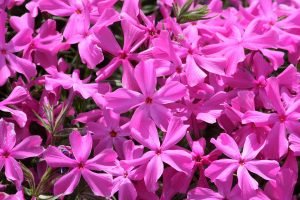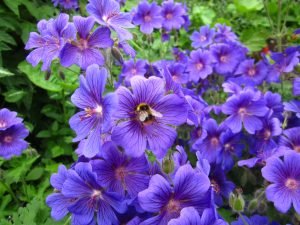In the last blog, we discussed the first five of ten perennial plants to refresh the yard with colour. Of course, many of the hardy perennial plants can help when the landscape may include slopes or even somewhat difficult growing conditions which require hardier plants. Many of the flowering perennials are easy to grow and maintain, allowing us to balance the time we spend with our family in a variety of activities throughout the summer months and the time we’d like to spend in the garden.
With a little up front organizing and planning, garden tool storage as well as composting bin storage can be worked into the garage. The slatwall organization system of storage offers options for tools, lawn mowers and supplies for the gardener who needs easy access to both the front and back yard gardens and who wants to avoid taking up valuable landscape with a garden shed. A garage renovation makes it possible to offer convenient access to gardening tools and supplies. Of course, one of the most important steps in gardening is planning or choosing perennials based on the garden’s access to sun and the qualities of the soil. Here are the last five of the ten perennial flower choices that we would like to review.
Shasta daisy (Leucanthemum x superbum)
 The sunny and sweet Shasta daisy is a classic perennial. The blooms on these daisies are larger and more robust than the wild roadside daisies. These flowers have white petals and deep yellow florets and they will blossom every year in late spring or early summer until early fall. They are 2 to 3 feet tall and grow in clumps which are 1 to 2 feet in width.
The sunny and sweet Shasta daisy is a classic perennial. The blooms on these daisies are larger and more robust than the wild roadside daisies. These flowers have white petals and deep yellow florets and they will blossom every year in late spring or early summer until early fall. They are 2 to 3 feet tall and grow in clumps which are 1 to 2 feet in width.
They love full sun and good soil with proper drainage so use your compost to enrich the garden bed for these flowers every year. And, after the first killing frost of the fall, cut back the stems to 1 to 2 inches for best results in the following season.
Phlox
 These star shaped flowers grow in clusters creating great ground cover. The creeping phlox in particular enjoys shade and would work well around and under shrubs as ground cover. They are easy to grow and maintain like many of the perennials. It’s easiest to grow phlox from a cutting than from a seed.
These star shaped flowers grow in clusters creating great ground cover. The creeping phlox in particular enjoys shade and would work well around and under shrubs as ground cover. They are easy to grow and maintain like many of the perennials. It’s easiest to grow phlox from a cutting than from a seed.
Plant them in spring in moist compost rich soil. Different phlox want a variety of conditions. Border phlox like Carolina phlox, Meadow phlox, and Garden phlox want moist, well-drained soil as well as full to partial sun. Low, mounding phlox like Sand phlox and Chattahoochee don’t mind average to sandy soil which is well-drained with full sun. Woodland species like Blue phlox and Creeping phlox need moist, humus-rich or in other words, mature nutrient rich compost with full to partial sun.
Purple Coneflower
 The purple coneflower is Echinacea and it is as sturdy as it is beautiful. The flowers have purple leaves and a cone at the centre where the seeds of the flower are found. The seeds in the cone attract both birds and butterflies to the garden. The flowers bloom in mid-summer and they are so hardy that they fare well in heat while being rather drought resistant.
The purple coneflower is Echinacea and it is as sturdy as it is beautiful. The flowers have purple leaves and a cone at the centre where the seeds of the flower are found. The seeds in the cone attract both birds and butterflies to the garden. The flowers bloom in mid-summer and they are so hardy that they fare well in heat while being rather drought resistant.
They also repel deer so if you’ve got a vegetable garden nearby, it’s a handy flower to have around to keep your garden free of wildlife wandering through the vegetables and munching their way through a season of your hard work.
There are a variety of purple coneflower colours. The Robert Bloom has dark orange centers with bright crimson flower petals. The Tennessee coneflower has greenish-pink centers with dark mauve flower petals. The Finale White has creamy white flower heads with greenish-brown centers.
Bleeding Heart (Dicentr)
 The bleeding heart flower appears in early spring as heart shaped pink and white flowers or just white flowers all strung along the arched stem of the plant. The foliage is a beautiful bluish green. The bleeding heart needs a cool shady spot in the garden with moist nutrient rich compost soil which drains well. They do well being planted in the spring or fall.
The bleeding heart flower appears in early spring as heart shaped pink and white flowers or just white flowers all strung along the arched stem of the plant. The foliage is a beautiful bluish green. The bleeding heart needs a cool shady spot in the garden with moist nutrient rich compost soil which drains well. They do well being planted in the spring or fall.
The heat of summer will cause the bleeding heart to wither away but there’s no need to cut away the dying foliage as the plant is taking this time to store away food reserves for the following year’s new growth of the flowers. Over time, the clump of bleeding heart flowers can become overwhelming and they can be separated with part of the clump planted elsewhere in the garden.
The bleeding heart plant grows from 1.5 to 4 feet tall.
Cranesbill (Geranium sanguineum)
 The cranesbill or hardy geranium is beautiful and easy to grow perennial with violet-blue petals typically. They are resistant to pests and disease and do well in a variety areas in a garden. The growing conditions include soil which is moist, well-drained and nutrient rich so top up your garden with compost each spring to keep the ground well suited to these plants. Some do well in full sun areas and they also do well in partial sun conditions as well.
The cranesbill or hardy geranium is beautiful and easy to grow perennial with violet-blue petals typically. They are resistant to pests and disease and do well in a variety areas in a garden. The growing conditions include soil which is moist, well-drained and nutrient rich so top up your garden with compost each spring to keep the ground well suited to these plants. Some do well in full sun areas and they also do well in partial sun conditions as well.
And, the gardener’s reward is a perennial which produces a long bloom from spring until late fall. These flowers come in a variety of colours including purple, blue, white, and pink. The flowers have 5 petals which are from ½ to 1½ inch wide with the typical colour being violet-blue petals of a Rozanne variety. The geranium is often confused with the flowers called pelargoniums at the local garden centres. The pelargoniums are a ball shaped bundle of flowers and the garden centres often market these as geraniums. However, the pelargoniums are annuals and are not the hardy geraniums which are perennials.
Spring Garden Tool & Supply Storage
If you feel unprepared to store the variety of supplies and tools for your garden, consider a garage renovation to maximize your landscaping space while organizing your garage and yard space. Then, you can enjoy looking after an easy to maintain perennial garden. A complimentary in-home consultation with one of our garage renovation specialists can help you. Whether you need to care for perennials or you have other lifestyle activities which may end up using storage space in the garage, call on Garage Tailors Garage to help you plan and design the garage space.




